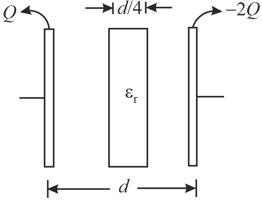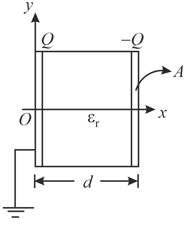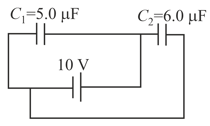A charged capacitor has energy and , in the absence of a dielectric. When the potential difference is kept constant by keeping the capacitor connected to the supply, assuming
(i) find the new energy stored when the dielectric slab is completely filled with the capacitor. Account for this change in energy
(ii) how much excess charge flows from the supply
(iii) find the ratio of the charge on the plate of the capacitor and the charge induced on the dielectric

Important Questions on Capacitor and Capacitance
A dielectric slab of thickness and relative permittivity is inserted between two parallel conducting plates each of area kept at a separation . Find the

(a) The charge density in the inner side of conductors
(b) The charge density on the dielectric slab
(c) The electric field in the dielectric
(d) The potential difference between the conductor
(e) The capacitance
The separation between the plates of a parallel-plate capacitor is . A field of is established between the plates. It is disconnected from the battery and an uncharged metal plate of thickness is inserted between the plates of the capacitor.
(a) What would be the potential difference across the capacitor, before the introduction of the metal plate and after its introduction.
(b) What would be the potential difference if a plate of dielectric constant is introduced in place of metal plate?
A dielectric slab is filled in the space between the parallel plate capacitor whose relative permittivity varies as,
Find: (a) capacitance of the system
(b) potential at a point situated at a distance from the origin inside of capacitor.

If you have several capacitors, each capable of withstanding without breakdown, how would you assemble a combination that has an equivalent capacitance of:
(a)
(b) each withstanding
Find the equivalent capacitance between points and as shown in figure.


